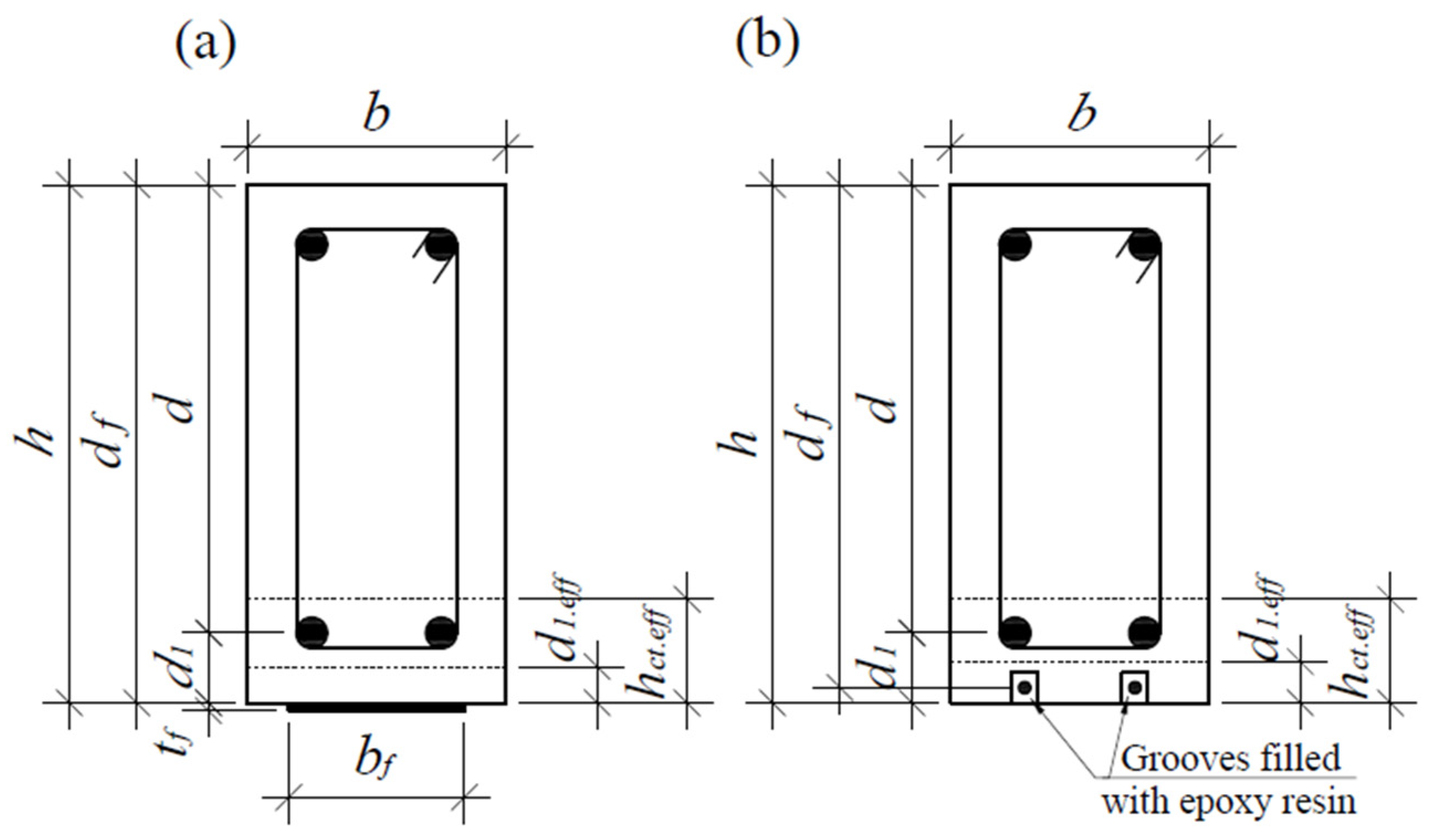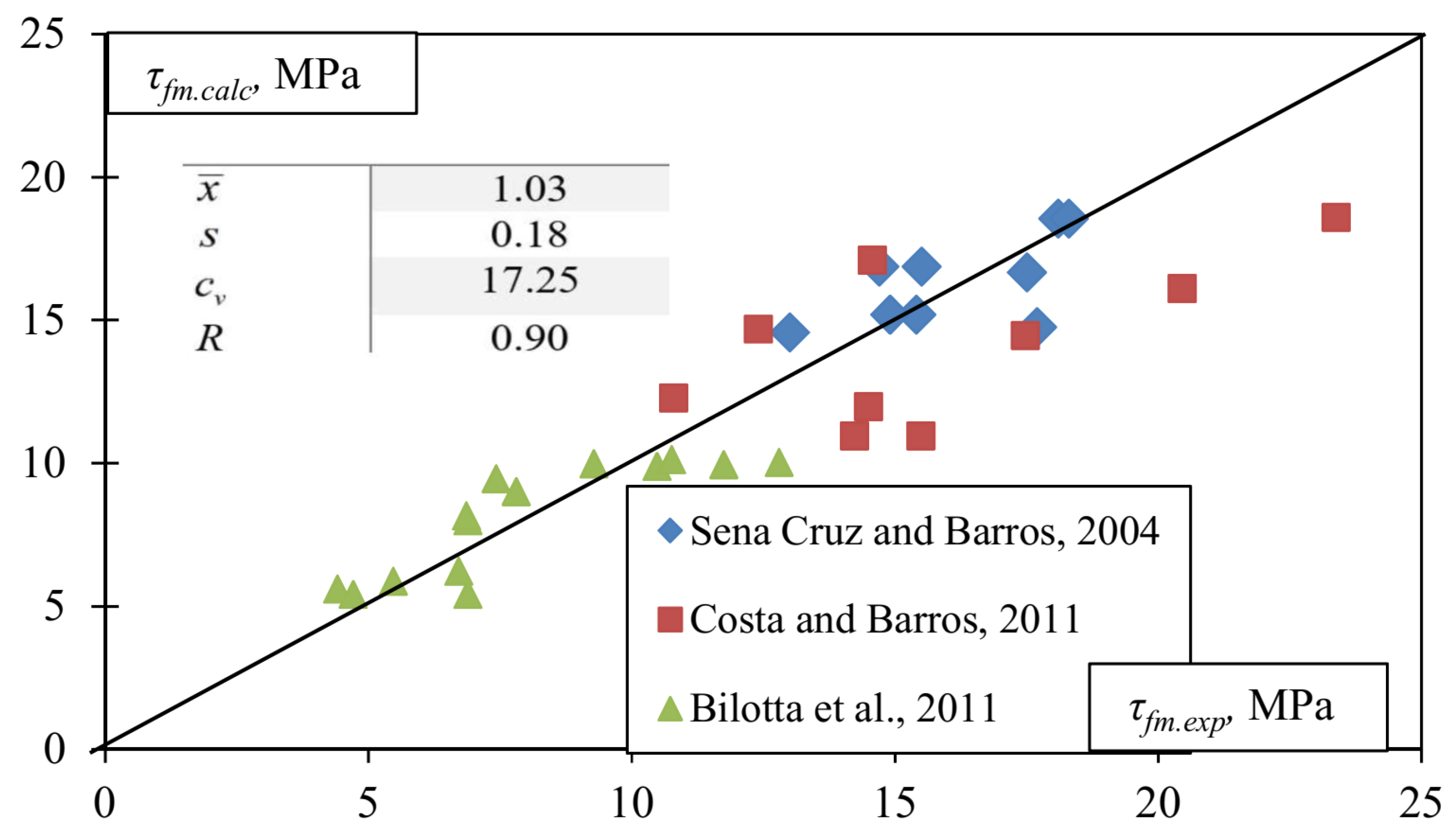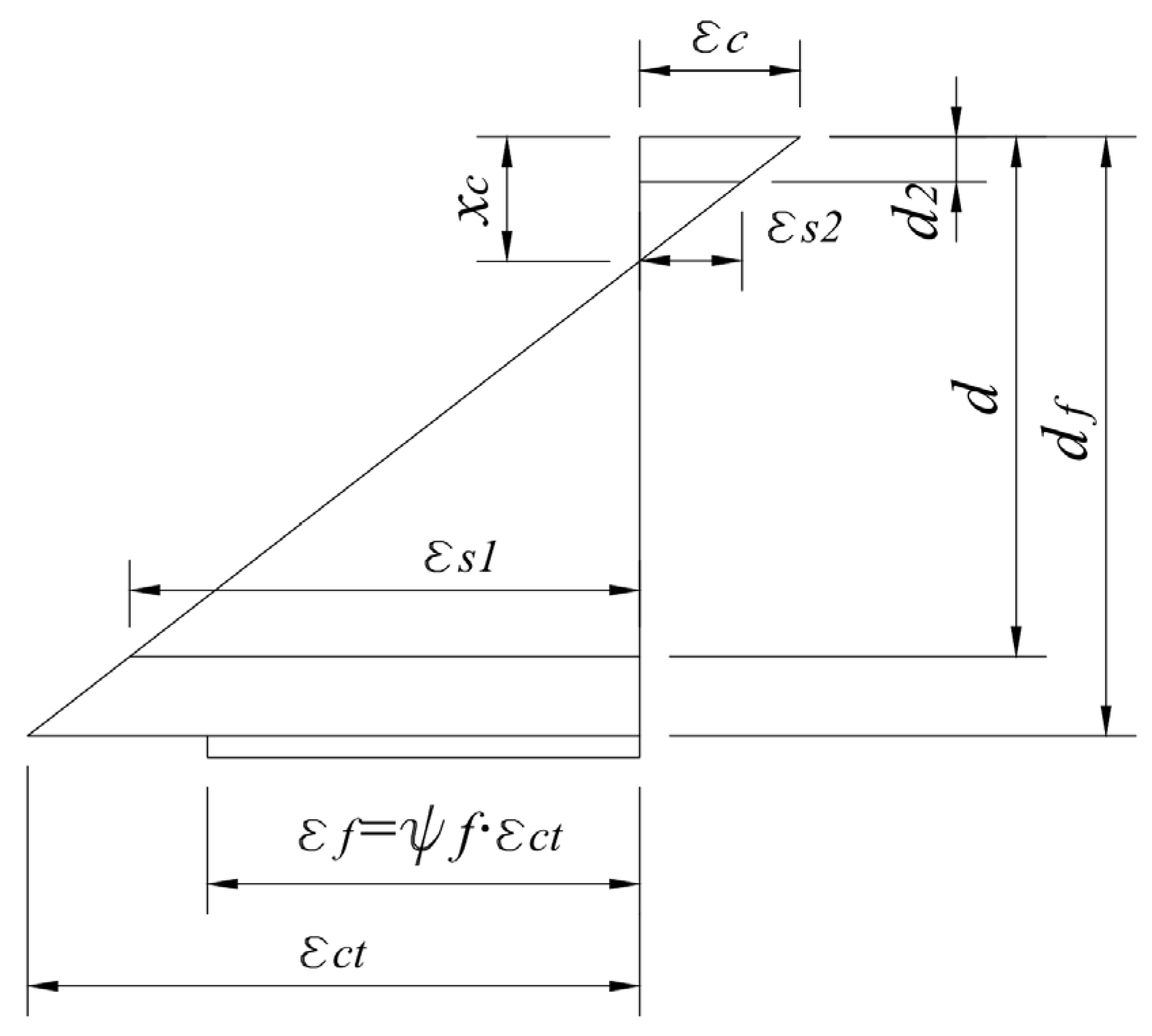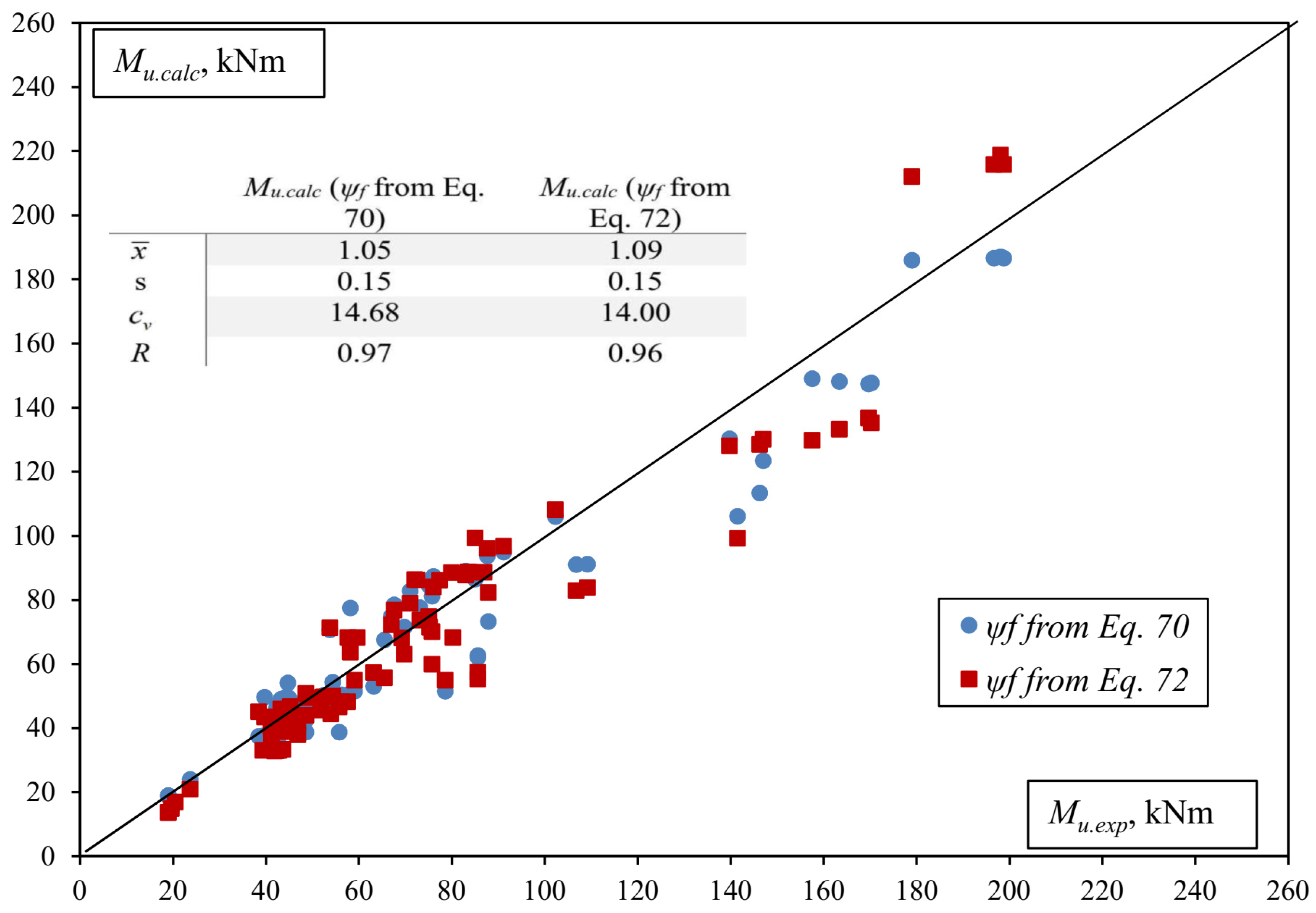Universal Bond Models of FRP Reinforcements Externally Bonded and Near-Surface Mounted to RC Elements in Bending
Abstract
:1. Introduction
2. Bond Model Based on the Fracture Mechanics of Solids
3. Bond Model Based on Built-Up Bars Theory
4. Load-Bearing Capacity
5. Validation of the Results
6. Conclusions
- In this paper, two different universal models are presented for the assessment of the bond between concrete and FRPs, both of which assess the behaviour of the bond between two cracks. The first model is based on the fracture mechanics of solids, distinguishing different stages of failure development and distribution over the length of the joint. The second one is the fully analytical model based on the built-up bars theory, considering the joint as a single unit.
- In both cases, the load-bearing capacity of the member’s normal section is determined very accurately with a low mean error (5% and 9%), a low random error (0.15 in both cases), and a high correlation (0.97 or 0.96). The results of the calculation have been validated with 77 beam tests carried out by different researchers. The beams were strengthened using both EBR and NSM methods, with strong variations in performance. Both the prestress force and the initial stress state before strengthening were evaluated.
- The first approach, based on the fracture mechanics of solids, has advantages over the second approach in that it allows for a complete analysis of the behaviour of the joint, the development, and the propagation of rupture. However, the second approach is well suited to the calculation of the load-bearing capacity, requires much less computation, and can be fully exploited where it is sufficient to treat the joint as a unit, without subdividing.
- The most common description of a concrete–FRP bond found in the literature is based on some specific testing, or it is greatly simplified, resulting in a number of limitations in the application and a number of aspects that are not assessed. The significance of this paper lies in the fact that the proposed models are universal, not tied to specific tests, suitable for different strengthening methods, do not use any major simplifications, and the only limitation is the normal section of the bending element.
Funding
Institutional Review Board Statement
Informed Consent Statement
Data Availability Statement
Conflicts of Interest
References
- Mcguirk, G.N.; Breña, S.F. Development of Anchorage System for FRP Strengthening Applications Using Integrated FRP Composite Anchors; Concrete Research Council of the ACI Foundation: Farmington Hills, MI, USA, 2012; 277p. [Google Scholar]
- Skuturna, T.; Valivonis, J. The Statistical Evaluation of Design Methods of the Load-Carrying Capacity of Flexural Reinforced Concrete Elements Strengthened with FRP. Arch. Civ. Mech. Eng. 2015, 15, 214–222. [Google Scholar] [CrossRef]
- Panjehpour, M.; Farzadnia, N.; Demirboga, R.; Ali, A.A.A. Behavior of High-Strength Concrete Cylinders Repaired With Cfrp Sheets. J. Civ. Eng. Manag. 2015, 22, 56–64. [Google Scholar] [CrossRef]
- Benzaid, R.; Mesbah, H.A. The Confinement of Concrete in Compression Using CFRP Composites-Effective Design Equations. J. Civ. Eng. Manag. 2014, 20, 632–648. [Google Scholar] [CrossRef]
- Bakis, C.E.; Bank, L.C.; Asce, F.; Brown, V.L.; Asce, M.; Cosenza, E.; Davalos, J.F.; Asce, A.M.; Lesko, J.J.; Machida, A.; et al. Fiber-Reinforced Polymer Composites for Construction —Review. J. Compos. Constr. 2002, 6, 73–77. [Google Scholar] [CrossRef]
- Kim, Y.J.; Green, M.F.; Wight, R.G. Prestressed Fiber-Reinforced Polymer (FRP) Composites for Concrete Structures in Flexure: Fundamentals to Applications. In Advanced Composites in Bridge Construction and Repair; Woodhead Publishing Limited: Sawston, UK, 2014; ISBN 9780857097019. [Google Scholar]
- Atutis, M.; Valivonis, J.; Atutis, E. Analysis of Serviceability Limit State of GFRP Prestressed Concrete Beams. Compos. Struct. 2015, 134, 450–459. [Google Scholar] [CrossRef]
- Skuturna, T.; Valivonis, J. Experimental Study on the Effect of Anchorage Systems on RC Beams Strengthened Using FRP. Compos. Part B Eng. 2016, 91, 283–290. [Google Scholar] [CrossRef]
- Skuturna, T.; Valivonis, J. Evaluation of Calculation Methods Used for Estimating the Ultimate Moment Resistance of Bridge Decks Reinforced with Frp Bars. Balt. J. Road Bridg. Eng. 2016, 11, 22–34. [Google Scholar] [CrossRef]
- Skuturna, T.; Valivonis, J.; Vainiunas, P.; Marciukaitis, G.; Daugevicius, M. Analysis of Deflections of Bridge Girders Strengthened by Carbon Fibre Reinforcement. Balt. J. Road Bridg. Eng. 2008, 3, 145–151. [Google Scholar] [CrossRef]
- Valivonis, J.; Skuturna, T. Cracking and Strength of Reinforced Concrete Structures in Flexure Strengthened with Carbon Fibre Laminates. J. Civ. Eng. Manag. 2007, 13, 317–323. [Google Scholar] [CrossRef]
- Valivonis, J.; Budvytis, M.; Atutis, M.; Atutis, E.; Jukneviɥius, L. Study on Shear Resistance of Fiberreinforced Polymer-Reinforced Concrete Beams. Adv. Mech. Eng. 2015, 7, 1–17. [Google Scholar] [CrossRef]
- ACI. ACI Committee 440: Guide for the Design and Construction of Externally Bonded FRP Systems for Strengthening Concrete Structures; American Concrete Institute: Farmington Hills, MI, USA, 2017; ISBN 9781945487590. [Google Scholar]
- Teng, J.G.; Smith, S.T.; Yao, J.; Chen, J.F. Intermediate Crack-Induced Debonding in RC Beams and Slabs. Constr. Build. Mater. 2003, 17, 447–462. [Google Scholar] [CrossRef]
- Liu, C.; Wang, X.; Chang, X.; Wu, Z.; Zhu, Z.; Wang, H.; Bian, Z. Experimental Study on Wedge Anchorage Performance of Prestressed BFRP Laminates for Flexural Strengthening of Reinforced Concrete Components. J. Compos. Constr. 2023, 27, 04023043. [Google Scholar] [CrossRef]
- Peng, H.; Zhang, J.; Cai, C.S.; Liu, Y. An Experimental Study on Reinforced Concrete Beams Strengthened with Prestressed near Surface Mounted CFRP Strips. Eng. Struct. 2014, 79, 222–233. [Google Scholar] [CrossRef]
- Jung, W.T.; Park, Y.H.; Park, J.S.; Kang, J.Y.; You, Y.J. Experimental Investigation on Flexural Behavior of RC Beams Strengthened by NSM CFRP Reinforcements. In Proceedings of the SP-230: 7th International Symposium on Fiber-Reinforced (FRP) Polymer Reinforcement for Concrete Structures, Kansas City, MI, USA, 6–9 November 2005; pp. 795–806. [Google Scholar]
- Aktas, M.; Sumer, Y. Nonlinear Finite Element Analysis of Damaged and Strengthened Reinforced Concrete Beams. J. Civ. Eng. Manag. 2014, 20, 201–210. [Google Scholar] [CrossRef]
- Shukri, A.A.; Ud Darain, K.M.; Jumaat, M.Z. The Tension-Stiffening Contribution of NSM CFRP to the Behavior of Strengthened RC Beams. Materials 2015, 8, 4131–4146. [Google Scholar] [CrossRef]
- Raafat El-Hacha, M.G. Flexural Strengthening of Reinforced Concrete Beams Using Prestressed, Mounted CFRP Bars. PCI J. Pap. 2011, 56, 134–151. [Google Scholar] [CrossRef]
- Barros, J.A.O.; Fortes, A.S. Flexural Strengthening of Concrete Beams with CFRP Laminates Bonded into Slits. Cem. Concr. Compos. 2005, 27, 471–480. [Google Scholar] [CrossRef]
- Rezazadeh, M.; Costa, I.; Barros, J. Influence of Prestress Level on NSM CFRP Laminates for the Flexural Strengthening of RC Beams. Compos. Struct. 2014, 116, 489–500. [Google Scholar] [CrossRef]
- Sharaky, I.A.; Torres, L.; Comas, J.; Barris, C. Flexural Response of Reinforced Concrete (RC) Beams Strengthened with near Surface Mounted (NSM) Fibre Reinforced Polymer (FRP) Bars. Compos. Struct. 2014, 109, 8–22. [Google Scholar] [CrossRef]
- Sharaky, I.A.; Torres, L.; Sallam, H.E.M. Experimental and Analytical Investigation into the Flexural Performance of RC Beams with Partially and Fully Bonded NSM FRP Bars/Strips. Compos. Struct. 2015, 122, 113–126. [Google Scholar] [CrossRef]
- Woo, S.K.; Nam, J.W.; Kim, J.H.J.; Han, S.H.; Byun, K.J. Suggestion of Flexural Capacity Evaluation and Prediction of Prestressed CFRP Strengthened Design. Eng. Struct. 2008, 30, 3751–3763. [Google Scholar] [CrossRef]
- TORRES, L.; SHARAKY, I.A.; BARRIS, C.; BAENA, M. Experimental Study of the Influence of Adhesive Properties and Bond Length on the Bond Behaviour of Nsm Frp Bars in Concrete. J. Civ. Eng. Manag. 2016, 22, 808–817. [Google Scholar] [CrossRef]
- Yao, J.; Teng, J.G.; Lam, L. Experimental Study on Intermediate Crack Debonding in FRP-Strengthened RC Flexural Members. Adv. Struct. Eng. 2005, 8, 365–396. [Google Scholar] [CrossRef]
- Smith, S.T.; Teng, J.G. FRP-Strengthened RC Beams. I: Review of Debonding Strength Models. Eng. Struct. 2002, 24, 385–395. [Google Scholar] [CrossRef]
- Atutis, M.; Valivonis, J.; Atutis, E. Experimental Study of Concrete Beams Prestressed with Basalt Fiber Reinforced Polymers. Part I: Flexural Behavior and Serviceability. Compos. Struct. 2018, 183, 114–123. [Google Scholar] [CrossRef]
- Slaitas, J.; Valivonis, J. Technological Peculiarities of Strengthening RC Members with Prestressed FRP Laminates. Compos. Struct. 2022, 290, 115526. [Google Scholar] [CrossRef]
- Meier, U. Strengthening of Structures Using Carbon Fibre/Epoxy Composites. Constr. Build. Mater. 1995, 9, 341–351. [Google Scholar] [CrossRef]
- Zeng, J.J.; Liao, J.J.; Zhuge, Y.; Guo, Y.C.; Zhou, J.K.; Huang, Z.H.; Zhang, L. Bond Behavior between GFRP Bars and Seawater Sea-Sand Fiber-Reinforced Ultra-High Strength Concrete. Eng. Struct. 2022, 254, 113787. [Google Scholar] [CrossRef]
- Liao, J.J.; Zeng, J.J.; Bai, Y.L.; Zhang, L. Bond Strength of GFRP Bars to High Strength and Ultra-High Strength Fiber Reinforced Seawater Sea-Sand Concrete (SSC). Compos. Struct. 2022, 281, 115013. [Google Scholar] [CrossRef]
- Peng, K.D.; Zeng, J.J.; Huang, B.T.; Huang, J.Q.; Zhuge, Y.; Dai, J.G. Bond Performance of FRP Bars in Plain and Fiber-Reinforced Geopolymer under Pull-out Loading. J. Build. Eng. 2022, 57, 104893. [Google Scholar] [CrossRef]
- Slaitas, J.; Valivonis, J. Bond Strength Evaluation Methods of RC Members Strengthened with FRP Composites. Eng. Struct. 2021, 249, 16. [Google Scholar] [CrossRef]
- Bianco, V.; Barros, J.; Monti, G. Shear Strengthening of RC Beams by Means of NSM CFRP Strips: A Proposal for Modeling Debonding; Report 07-DEC/E-29; Universidade do Minho: Guimarães, Portugal, 2007. [Google Scholar]
- Bianco, V.; Monti, G.; Barros, J.A.O. Design Formula to Evaluate the NSM FRP Strips Shear Strength Contribution to a RC Beam. Compos. Part B Eng. 2014, 56, 960–971. [Google Scholar] [CrossRef]
- Slaitas, J.; Valivonis, J.; Juknevičius, L.; Šalna, R. Load-Bearing Capacity of Flexural Reinforced Concrete Members Strengthened with Fiber-Reinforced Polymer in Fracture Stage. Adv. Mech. Eng. 2018, 10, 1–16. [Google Scholar] [CrossRef]
- Slaitas, J.; Daugevičius, M.; Valivonis, J.; Grigorjeva, T. Crack Width and Load-Carrying Capacity of RC Elements Strengthened with FRP. Int. J. Polym. Sci. 2018, 2018, 6274287. [Google Scholar] [CrossRef]
- Slaitas, J.; Valivonis, J.; Rimkus, L. Evaluation of Stress-Strain State of FRP Strengthened RC Elements in Bending. Fracture Mechanics Approach. Compos. Struct. 2020, 233, 111712. [Google Scholar] [CrossRef]
- Slaitas, J.; Valivonis, J. Concrete Cracking and Deflection Analysis of RC Beams Strengthened with Prestressed FRP Reinforcements under External Load Action. Compos. Struct. 2021, 255, 113036. [Google Scholar] [CrossRef]
- Slaitas, J.; Šalna, R.; Valivonis, J. Anchoring Issues of CFRP Laminates to Concrete Members. Polymers 2022, 14, 2338. [Google Scholar] [CrossRef] [PubMed]
- Jung, W.T.; Park, J.S.; Kang, J.Y.; Keum, M.S. Flexural Behavior of Concrete Beam Strengthened by Near-Surface Mounted CFRP Reinforcement Using Equivalent Section Model. Adv. Mater. Sci. Eng. 2017, 2017, 9180624. [Google Scholar] [CrossRef]
- Fu, B.; Chen, G.M.; Teng, J.G. Mitigation of Intermediate Crack Debonding in FRP-Plated RC Beams Using FRP U-Jackets. Compos. Struct. 2017, 176, 883–897. [Google Scholar] [CrossRef]
- EN 1992-1-1; Eurocode 2: Design of Concrete Structures—Part 1–1: General Rules and Rules for Buildings. European Commitiee for Standardization: Bruxelles, Belgium, 2004.
- ACI. ACI 318-14: Building Code Requirements for Structural Concrete; ACI Committee: Farmington Hills, MI, USA, 2014; ISBN 9780870319303. [Google Scholar]
- International Federation for Structural Concrete (fib). Fib Model Code for Concrete Structures 2010; Wilhelm Ernst & Sohn: Berlin, Germany, 2013; ISBN 978-3-433-03061-5. [Google Scholar]
- International Federation for Structural Concrete (fib). Externally Bonded FRP Reinforcement for RC Structures; Technical Report No. 14; FIB International: Lausanne, Switzerland, 2001; ISBN 2883940541. [Google Scholar]
- De Sena Cruz, J.M.; Oliveira de Barros, J.A. Bond Between Near-Surface Mounted Carbon-Fiber-Reinforced Polymer Laminate Strips and Concrete. J. Compos. Constr. 2004, 8, 519–527. [Google Scholar] [CrossRef]
- Costa, I.; Barros, J. Assessment of the Bond Behaviour of NSM FRP Materials by Pullout Tests. In Proceedings of the First Middle East Conference on Smart Monitoring, Assessment and Rehabilitation of Civil Structures, Dubai, United Arab Emirates, 8–10 February 2011; pp. 1–9. [Google Scholar]
- Bilotta, A.; Ludovico, M.D.; Nigro, E. FRP-to-Concrete Interface Debonding: Experimental Calibration of a Capacity Model. Compos. Part B Eng. 2011, 42, 1539–1553. [Google Scholar] [CrossRef]
- Visintin, P.; Oehlers, D.J.; Wu, C.; Haskett, M. A Mechanics Solution for Hinges in RC Beams with Multiple Cracks. Eng. Struct. 2012, 36, 61–69. [Google Scholar] [CrossRef]
- Bažant, Z.P.; Becq-Giraudon, E. Statistical Prediction of Fracture Parameters of Concrete and Implications for Choice of Testing Standard. Cem. Concr. Res. 2002, 32, 529–556. [Google Scholar] [CrossRef]
- Nikbin, I.; Rahimi, R.S.; Allahyari, H. A New Empirical Formula for Prediction of Fracture Energy of Concrete Based on the Artificial Neural Network. Eng. Fract. Mech. 2017, 186, 466–482. [Google Scholar] [CrossRef]
- Slaitas, J.; Valivonis, J. Full Moment-Deflection Response and Bond Stiffness Reduction of RC Elements Strengthened with Prestressed FRP Materials. Compos. Struct. 2020, 260, 113265, in press. [Google Scholar] [CrossRef]
- Dulinskas, E.; Zabulionis, D.; Balevičius, R. A Composition of Equivalent Compressive Stress Diagrams for Strength Analysis of Flexural Reinforced Concrete Elements. In Proceedings of the Statybinės Konstrukcijos; Technika: Vilnius, Lithuania, 2009; pp. 5–11. [Google Scholar]









| Ref. | As1/bd (%) | fy (MPa) | Af/bdf (%) | ff (MPa) | Ef (GPa) | σp (MPa) | EBR/NSM |
|---|---|---|---|---|---|---|---|
| [16] | 0.85 | 400 | 0.11 | 3100 | 165 | 1000 | EBR |
| [16] | 0.85 | 400 | 0.13–0.14 | 2068 | 131 | 0–1000 | NSM |
| [17] | 0.40 | 426 | 0.04–0.12 | 2453–3479 | 165–230 | 0 | EBR |
| [17] | 0.40 | 426 | 0.04–0.11 | 1878–2453 | 121–165 | 0 | NSM |
| [43] | 0.45 | 436 | 0.04–0.22 | 1500–2483 | 100–167 | 0 | NSM |
| [25] | 0.29–1.19 | 466–501 | 0.08 | 2850 | 165 | 0–1323 | EBR |
| [44] | 0.50–0.75 | 525–531 | 0.11 | 3263 | 251 | 0 | EBR |
| [23] | 0.58 | 545 | 0.12–0.26 | 1350–2350 | 64–170 | 0 | NSM |
| [24] | 0.58 | 540 | 0.13–0.26 | 1350–2500 | 64–170 | 0 | NSM |
| [20] | 0.77 | 475 | 0.08 | 2167 | 130 | 0–1241 | NSM |
| [21] | 0.54–0.94 | 730 | 0.16–0.24 | 2740 | 159 | 0 | NSM |
| [22] | 0.39 | 585 | 0.06 | 1922 | 164 | 0–823 | NSM |
| [39] | 0.68–1.13 | 318–569 | 0.08–0.32 | 2334–4800 | 213–230 | 0–120 | EBR |
Disclaimer/Publisher’s Note: The statements, opinions and data contained in all publications are solely those of the individual author(s) and contributor(s) and not of MDPI and/or the editor(s). MDPI and/or the editor(s) disclaim responsibility for any injury to people or property resulting from any ideas, methods, instructions or products referred to in the content. |
© 2024 by the author. Licensee MDPI, Basel, Switzerland. This article is an open access article distributed under the terms and conditions of the Creative Commons Attribution (CC BY) license (https://creativecommons.org/licenses/by/4.0/).
Share and Cite
Slaitas, J. Universal Bond Models of FRP Reinforcements Externally Bonded and Near-Surface Mounted to RC Elements in Bending. Materials 2024, 17, 493. https://doi.org/10.3390/ma17020493
Slaitas J. Universal Bond Models of FRP Reinforcements Externally Bonded and Near-Surface Mounted to RC Elements in Bending. Materials. 2024; 17(2):493. https://doi.org/10.3390/ma17020493
Chicago/Turabian StyleSlaitas, Justas. 2024. "Universal Bond Models of FRP Reinforcements Externally Bonded and Near-Surface Mounted to RC Elements in Bending" Materials 17, no. 2: 493. https://doi.org/10.3390/ma17020493





